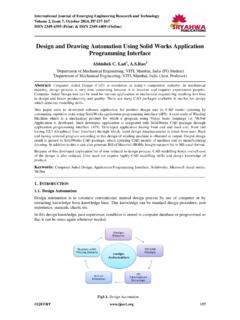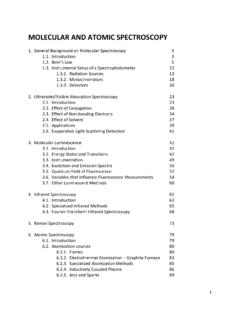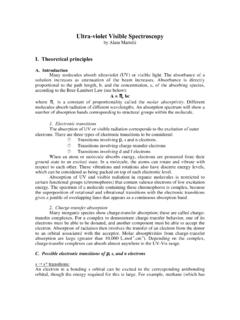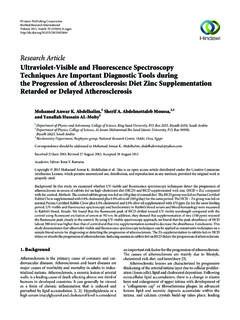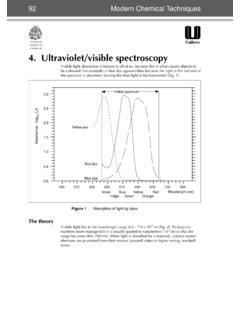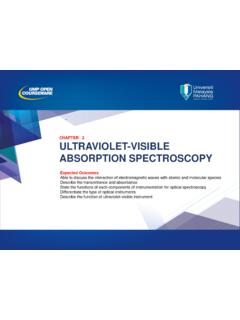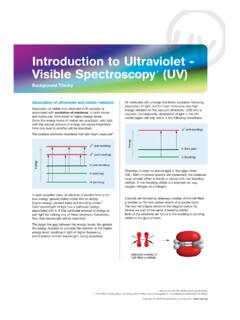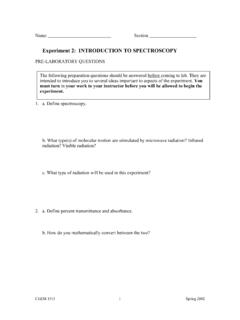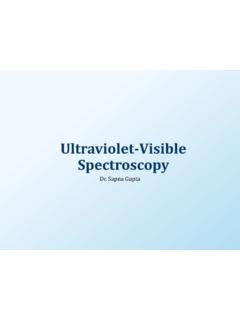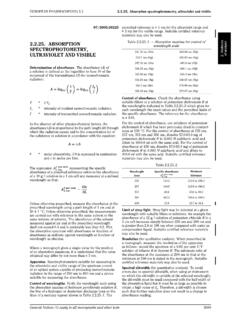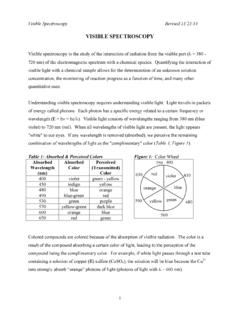Transcription of Primary Nutrients Determination in the Soil Using UV ...
1 International Journal of Emerging Engineering Research and Technology Volume 2, Issue 2, May 2014, PP 198-204 IJEERT 198 Primary Nutrients Determination in the soil Using UV spectroscopy Miss Yogita Kulkarni1, Dr. Krishna K. Warhade2, Dr. SusheelKumar Bahekar3 1 E&TC, MITCOE, Pune, India ( Student) 2 E&TC, MITCOE, Pune, India (Professor) 3 E&TC, MITCOE, Pune, India (Assistant Professor) Abstract: Objective of our research is to analyze soil properties for accurately mapping various Primary Nutrients in the soil . Various soil samples were taken from cultivated farms at the agriculture college , Pune A multi-parametric analytical system for measuring Primary Nutrients contents in cultivated soil is developed for on field analysis Using the techniques as UV spectroscopy .
2 This paper gives review of sensor technology used for sensing of Primary Nutrients in the and demonstrate fundamental results of UV spectroscopy method for on the go soil sensor. Keywords: Primary Nutrients , NPK, sensor technology, spectroscopy 1. INTRODUCTION Precision Agriculture (PA) can be define as a process of managing crop production input such as fertilizer, herbicide, insecticide, seed, etc. to reduce waste, increase profits, and maintain the quality of the environment Using information technology and electronics. It is an integrated crop management system that attempts to match the kind and amount of inputs with the actual crop needs for small areas within a farm.
3 [1]. Farmers usually are aware that their fields have variable yields across the landscape. These variations can be traced to management practices, soil properties and environmental characteristics. soil properties that affect yields include texture, structure, moisture, organic matter, nutrient status and environmental characteristics include weather, weeds, insects and diseases technologies for precision farming [2]. The vast array of tools for PA includes hardware, software and the best management practices. The most used techniques in precision agriculture are Global Positioning System (GPS) receivers, yield monitoring, grid soil sampling & mapping, Variable rate fertilizer (VRT) application, Remote Sensing(RS) and Crop scouting Research in precision agriculture has shown the high degree of spatial and temporal variability in Primary Nutrients content in the soil .
4 Variability in the soil properties can be sense by two methods as on field sensing and remote sensing[3]. In the remote sensing sensed data is monitored as well as control action is taken via satellite .It was found that a large array of agriculturally important soil properties were quantified with RS successfully to the various extents. On field sensors are of two types, on- the- go soil sample and intensive grid sampling. On-the-go sensors have the advantage of providing non-destructive and rapid quantification of soil variability to enable precision soil nutrient management and monitoring.
5 Intensive grid sampling is generally regarded as one of mapping the variability of crop and soil attributes in PA. However, intensive grid sampling is laborious, time consuming expensive and thus impractical for implementation in large scale [4]. On-the-go soil sensor technologies that can serve as a rapid method for measuring soil mechanical, physical and chemical properties are steadily developing. Table 1 shows different types of sensor that can be used to sense various properties of soil Table 1. On-the-go soil sensor types and their applications [4-6]. Sensor type Example applications Electrochemical soil pH, nitrate, potassium Electrical and electromagnetic soil texture (sand, silt, clay), soil moisture content soil depth variability cation exchange capacity Yogita Kulkarni et al.
6 International Journal of Emerging Engineering Research and Technology 199 Optical and radiometric soil organic matter, soil moisture Acoustic soil texture (sand, silt, clay), soil bulk density (compaction) soil depth variability (depth of topsoil, depth to hardpan) Mechanical soil compaction, compacted soil layers From the Table 1 it can be seen that there are three methods to sense Primary Nutrients which are Nitrogen, Phosphorous and Potassium (NPK) in the soil . These methods are conductivity measurement, optical method, and electrochemical methods to analyse concentration of Primary Nutrients .
7 Conductivity can be measured Using various electrodes such as steel, silver, platinum and graphit, copper. To measure electrical conductivity two or three electrodes of same material are immersed in samples. An voltage is applied to electrodes in sample. Another electrode is connected to Multimeter to measure the current changes. The voltage results in movements of ion which in turn results in variability of current of soil sample. Use of voltage avoids neutralization of ions. Varying current gives varying conductivity. Variability between electrical conductivity and concentration N, P, and K are observed.
8 As concentrations increases, variability in electrical conductivity increases [7]. Electrochemical sensors constitute Ion Selective Electrode (ISE) and Ion Selective Field Effective Transistor (ISFET). ISE and ISFET selects particular ion from samples Using sensor cocktail. ISEs/ISFETs uses different membranes, extraction solutions, and a multi-target system with coated wire field-effect transistor [ 8]. CW/FET type of electrochemical sensor uses a platinum wire coated with PVC which acts as the membrane matrix and it uses the cationic glass electrode (CGE) and the valinomycin-based selective electrode (VKE) for detection of exchangeable potassium in extracts from 30 soils [9].
9 All-solid-state sensors were built by Aleix Parra et al.[10]. They have applyed ion-selective polymeric membranes over an inner solid contact prepared with graphite-epoxy composites Using a copper plate as a reference electrode. Nitrogen is found in the form of NH4+, NO32- NO2. Thus various ammonia sensor can helps in detection of nitrogen. Ammonia Determination can be done Using dodecylbenzenesulfonate (DBSA) doped polypyrrole film [11]. The last type for soil sensor technology is optical sensor. Principal of optical techniques is based on the interaction between incident light and soil surface properties, such that the characteristics of the reflected light vary due to the soil physical and chemical properties Laser Induced Florescence spectroscopy (LIFS) is optical technique in which analyte in the molecule absorbs radiation at a certain wavelength (usually UV and visible regions).
10 The electrons of the analyte are excited to higher energy states from ground state, but soon relaxation occurs from higher vibrational states to the lower vibrational state of the excited electronic state. Following this relaxation, the electrons return back to their ground state by emitting a photon [12-13] Near InfraRed spectroscopy (NIR) technique is very widely used for experimental as well as commercial purpose. NIR is a spectrophotometric method that deals with the interactions of near infrared radiation with the sample under investigation. It is based on the absorption of electromagnetic radiation at wavelengths in the range of 780-2500 nm.
